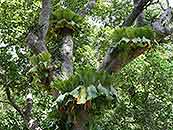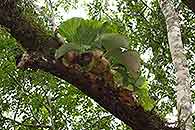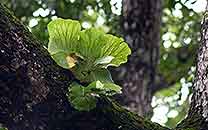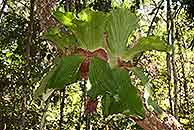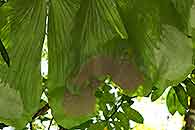Platycerium elephantotis Schweinf.
Synonyms |
Platycerium angolense Welw. ex Baker |
|---|---|
Common name |
Itala dawikulukulu Mutuntami |
Description |
Rhizome c. 1 cm. in diameter; rhizome scales awl-shaped, ciliate, up to 1.5 cm. long, brown with a central black stripe. Fronds dimorphous. Sterile fronds lower part thick and spongy, upper part membranous, up to 75 x 30 cm., erect, oblong in outline, overlapping at the cordate base and forming a large thalloid mass, prominently veined in the upper 2/3, margin entire to irregularly wavy at the apex, covered at first with grey stellate hairs, becoming hairless with age. Fertile fronds up to 75 x 55 cm., broadly obtriangular in outline, apex rounded, margin entire to subentire, coriaceous, subglabrous above, densely set below with rufous stellate hairs c. 1 mm. in diameter. Sporangia covering a large oval area of about 20-40 x 10-40 cm. below the frond apex, densely set with brown stellate hairs similar to those on the lamina. |
Notes | The fertile frond is broadly cuneate, lacking the ‘stag horns’ of the commonly cultivated species. |
Derivation | eléphantos: elephant, otis: ear; an allusion to the very large and broad fronds. |
Habitat | Large trees in dry forests, mixed evergreen forest, at forest edges, woodland, on Raphia palms, Erythrina, in light shade or full sunlight. |
Distribution worldwide | See African distribution. |
Distribution in Africa |
Angola, Benin, Burundi, Cameroon, Congo, Dem. Republic of Congo, Ethiopia, Gabon, Ghana, Guinea, Ivory Coast, Kenya, Liberia, Malawi, Mozambique, Nigeria, Rwanda, Senegal, Sierra Leone, Sudan and South Sudan, Tanzania , Togo, Uganda, Zambia. |
Growth form |
Epiphytic, lithophytic. |
Literature |
|

